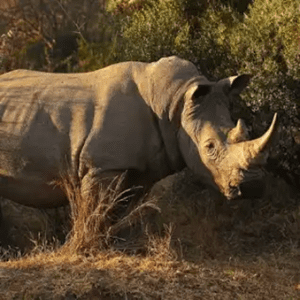TAG: GS 3: ECOLOGY AND ENVIRONMENT
THE CONTEXT: Amidst the looming threat of extinction, a ray of hope shines through the dense jungles of Java as conservationists capture an image of a critically endangered Javan rhinoceros calf through a camera trap.
EXPLANATION:
- This significant sighting offers a glimpse into the fragile existence of one of the rarest mammals on Earth and signals a potential for the recovery of a population teetering on the brink of extinction.
Status of the Javan Rhino Population:
- The Javan rhinoceros (Rhinoceros sondaicus) stands as a symbol of conservation urgency, with fewer than 100 individuals left in the wild.
- Ujung Kulon National Park in Java serves as the last stronghold for these majestic creatures, with approximately 82 rhinos inhabiting its 463 square miles of pristine habitat.
- Despite being slightly higher than previous estimates, this population remains critically vulnerable to a myriad of threats, including illegal poaching, habitat loss, food scarcity, and disease.
Conservation Efforts and Breeding Success:
- Efforts to safeguard the Javan rhinoceros have yielded promising results, as evidenced by the recent sighting of a calf in the wild.
- The installation of 126 camera traps within Ujung Kulon National Park has provided invaluable insights into the behavior and reproductive success of these elusive creatures.
- Authorities express optimism regarding the breeding potential of the rhinos, citing the sighting of the calf as evidence of successful reproduction within the population.
- This development underscores the importance of ongoing conservation initiatives aimed at preserving the genetic diversity and reproductive viability of the species.
Challenges and Threats:
- Despite recent strides in conservation, the road to recovery remains fraught with challenges.
- Illegal poaching continues to pose a significant threat to the survival of Javan rhinoceros, driven by the demand for rhino horn in traditional medicine and illegal wildlife trade.
- Habitat fragmentation and degradation further exacerbate the plight of these creatures, limiting their access to vital resources and exacerbating human-wildlife conflicts.
- Additionally, disease outbreaks, compounded by small population sizes, pose a looming threat to the long-term viability of the species.
Broader Conservation Context:
- The plight of the Javan rhinoceros serves as a stark reminder of the urgent need for concerted conservation efforts to safeguard Earth’s biodiversity.
- While the focus remains on the Javan population, conservationists also highlight the plight of the Sumatran rhinoceros, another critically endangered species facing imminent extinction.
- With a population of only around 40 individuals, efforts to protect the Sumatran rhinoceros are equally vital in ensuring the survival of this iconic species.
Javan rhinoceros:
- The Javan rhino, also known as the lesser-one-horned rhino, is the most threatened of the five rhino species.
- Its scientific name is Rhinoceros sondaicus.
- They once lived throughout northeast India and Southeast Asia.
- Today, the entire population of the Javan rhinos is found in the Ujung Kulon National Park on the very western tip of Java, Indonesia.
- They inhabit forests, marshy areas, and regions of thick bush and bamboo.
- In 2020, park managers, relying on camera trap data to identify and track the animals, estimated that no more than 68–74 surviving individuals remained.
- Javan rhinoceros are smaller and lighter relative of the greater one-horned rhino. They can reach a height of 1.7 m (5.6 ft) and weigh up to 2,300 kg (5,070 lb).
- They have grey or grey-brown skin, almost black when wet, with pink colouring in the folds.
- Similar to the Indian rhino, the Javan rhinoceros has a single horn, unlike the other three species of rhinos, which have two.
- It has the smallest of horns for all species of rhinoceros measuring less than 20 cm (7.9 in) in length.
- Lifespan: 30 to 45 years in the wild.
- They’re herbivorous, only eating plants.
- They’re solitary animals, except for mating pairs and mothers with young.
- As per the conservation status of IUCN Red List, they are categorized as Critically Endangered.

Indian rhinoceros:
- The Indian rhinoceros (Rhinoceros unicornis) is found only in the Brahmaputra valley, parts of North Bengal, and parts of southern Nepal.
- It has a single black horn that can grow up to 60 cm, and a tough, grey-brown hide with skin folds, which gives the animal its characteristic armour-plated look.
- The Indian rhino is listed as vulnerable (better than endangered, worse than near threatened) in the IUCN Red List; it was earlier placed in the endangered category.
- According to the WWF, there are around 3,700 Indian rhinos in the wild today. Assam’s Kaziranga National Park (KNP) alone has 2,613 animals, according to a census carried out in March 2022.
- There are more than 250 other rhinos in the Orang, Pobitora, and Manas parks.
SOURCE: https://gizmodo.com/endangered-javan-rhino-calf-spotted-in-the-wild-1851394713
Spread the Word
